In July we reported on how Facebook algorithm changes affected Nordic media publishers. SocialFlow had previously analysed the impact of the changes in the USA. They reported a worrisome 42% drop off in news publishers’ Facebook reach in the US. Our main takeaway was that Nordic news publishers got off quite lightly – except Norway who was affected to the same degree as the US.
We also found that in Norway, videos got a bigger reach bump than expected. This was related to another algorithm change – Facebook’s experiments with video content.
We also noticed that despite the drop off for news publishers, viral publishers remained steady in Nordic countries.
In this blog post, we turn our analytical gaze upon a much bigger country: Spain.
Spain is particularly interesting to look at for several reasons. The whole media industry is in a precarious state that some refer to as a crisis of the Spanish news industry. Spain also has a media landscape of many strong regional publications and people consume viral content in massive volumes.
While a 42% drop off in Facebook reach was damaging in the US, it could be disastrous for Spain’s news industry. What we see is not at all what we expected, however.
We’re focusing on engagement data across the top 10 publishers in Spain. We’ll show how they performed over the first half of 2016. This was the time the major Facebook algorithm changes took place.
The top 10 publishers
We have good data for ten publishers that belong to the top Spanish publishers ranked by total engagement (likes, reactions, shares & comments). They are El País, Diario Público, El Mundo, ABC.es, eldiario.es, Diario SUR, La Provincia, El Comercio Digital, Ideal.es and Diario de Avisos. Our data does not contain all the current top 20 publishers (that would also include La Vanguardia, laSexta I Noticias, Antena 3 Noticias, RT en Espanol, 20minutos.es, Informativos Telecinco.com and El Huffington Post), as we don’t have historical data for them in this period. (We will for next year!)
Comparing engagement per post with the Nordics
Spanish news media seem to have suffered from any algorithm changes even less than the Nordics. What is most interesting here occurred at the end of April. Not only did Spanish publishers not experience a big drop like US, but the engagement per post actually rose after a small bump.
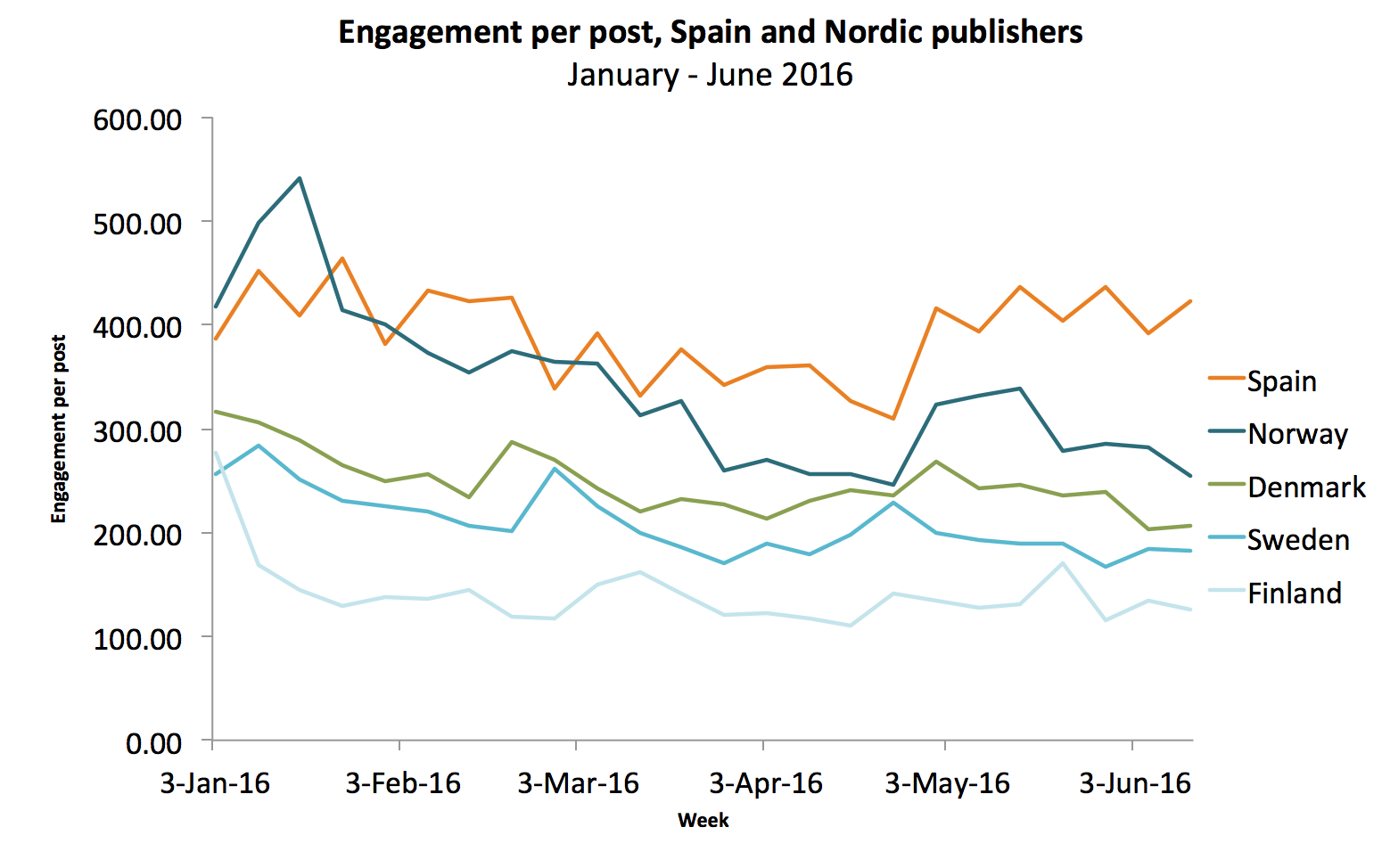 What are the possible reasons we don’t see the same drop off in Spain as in other countries?
What are the possible reasons we don’t see the same drop off in Spain as in other countries?
The fall in engagement per post in the Nordics was associated with an increase in the number of posts made. Put simply, posting more produces inflation. It seemed possible that the reason Spain did so well was that Spanish publishers did not increase their posting frequency like Nordics.
Not quite so. The publishing frequencies in each country followed a similar trend.
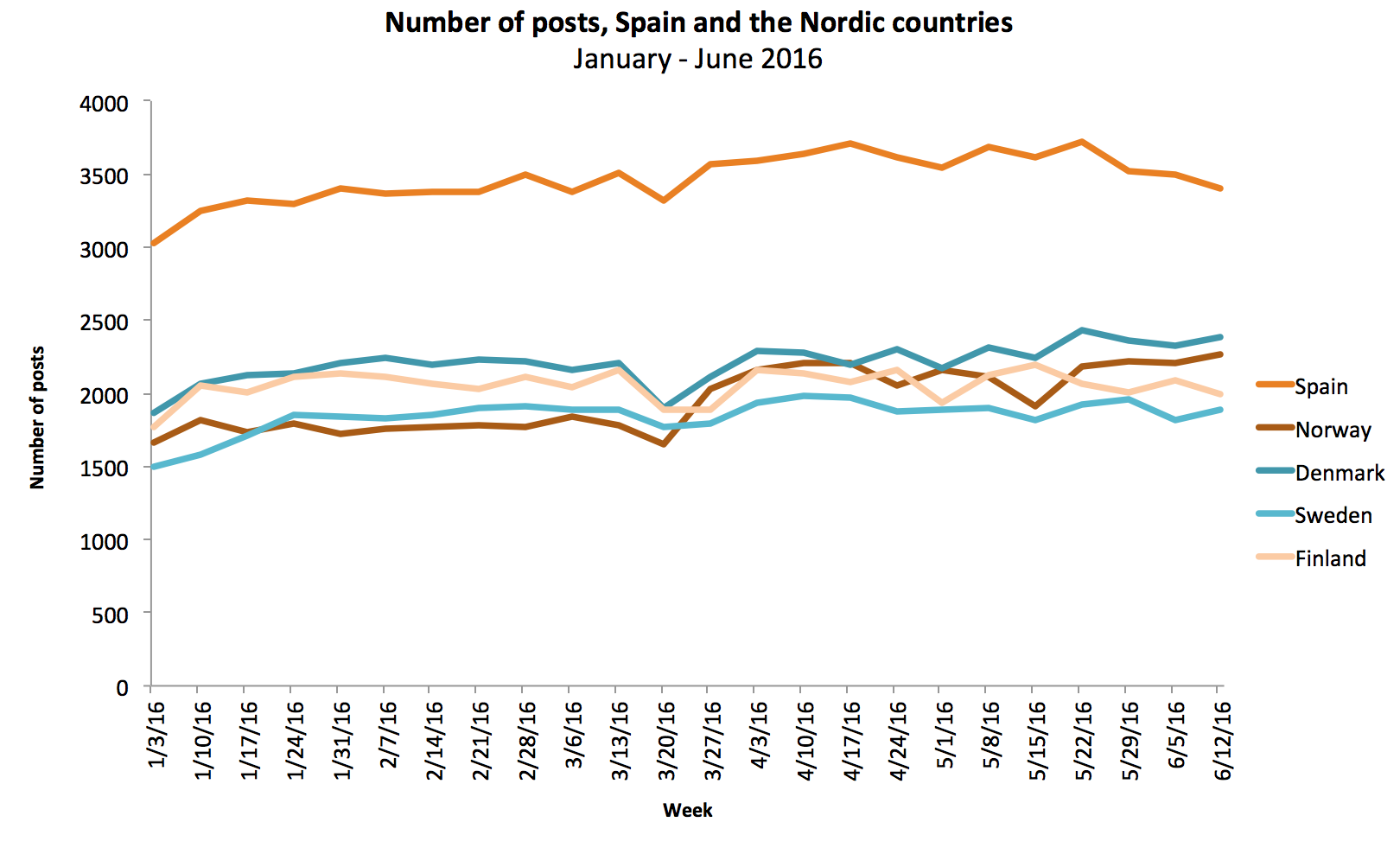 We see a very similar increase in number of posts made both in Spain and the Nordics. Yet, in Spain, more posts does not dilute the engagement rate!
We see a very similar increase in number of posts made both in Spain and the Nordics. Yet, in Spain, more posts does not dilute the engagement rate!
Furthermore, in comparison to Nordics and the US, Spanish publishers make a noteworthy exception. In addition to the per post engagement rate, let’s take a look at total engagement rate (sum of all the likes, reactions, comments and shares not proportioned by the amount of posts).
Total engagement rate for the top publishers of Spain has risen significantly in the summer.
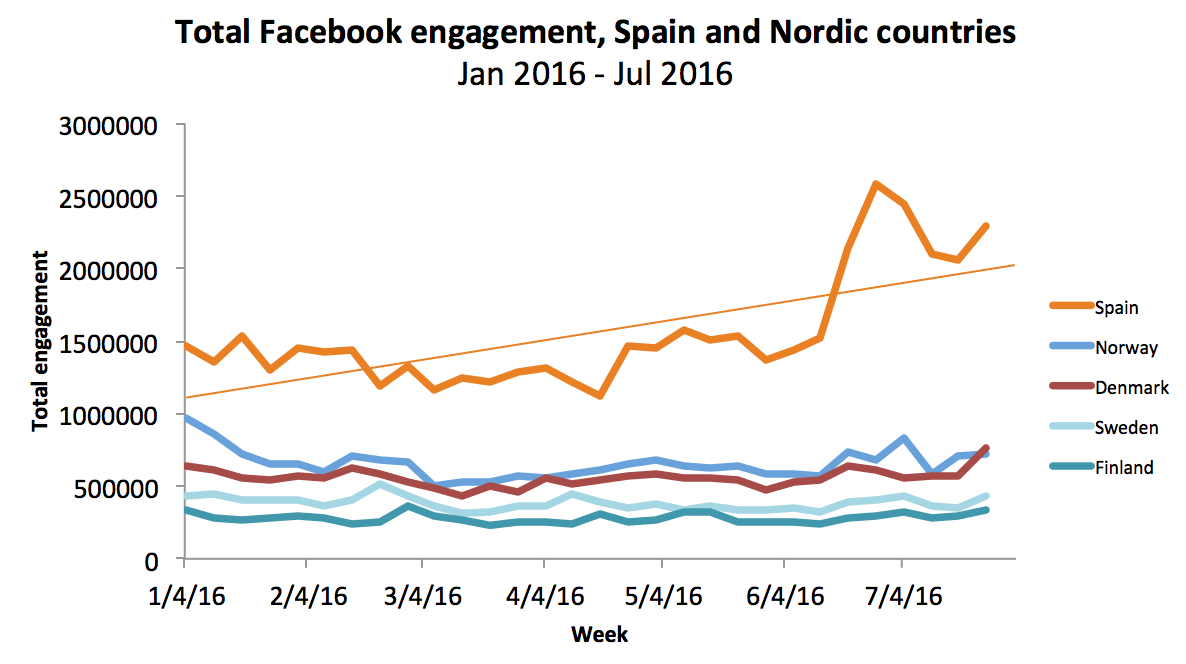 When Nordic publishers post more, the amount of total engagement remains stable. This means that more work is needed for reaching the same amount of engagement.
When Nordic publishers post more, the amount of total engagement remains stable. This means that more work is needed for reaching the same amount of engagement.
In Spain, increasing the amount of posts generates more engagement.
How and why did this happen?
Norway’s drop off centres around a temporary popularity boost that Facebook gave to live videos. Live videos got a lot more exposure than other kinds of posts. This was well visible in Norway’s data in March 2016, when live videos were introduced.
We speculated that the engagement rates were related to how different types of posts (videos, article links etc) were favoured by the Facebook news feed.
One might expect that when live video posts are favoured by Facebook, more live videos = more engagement.
Videos punch above their weight in engagement per post. Yet, we see that posting as many live videos as links does not automatically increase engagement.
Norway’s total and per post engagement rates went down despite a significant rise in the number of live video posts made and favoured by Facebook.
In comparison, the Spanish publishers have not been broadcasting much live video at all.
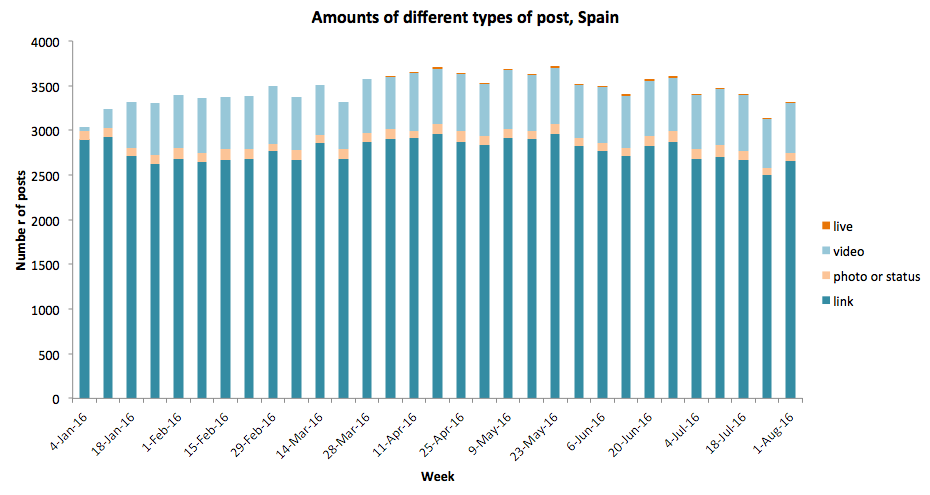
Live videos start to appear in Spanish data in March, but the ratio of live videos has not grown since then. But they are gaining a huge amount of engagement.
You can see this in the figure below, on the week starting 27th June.
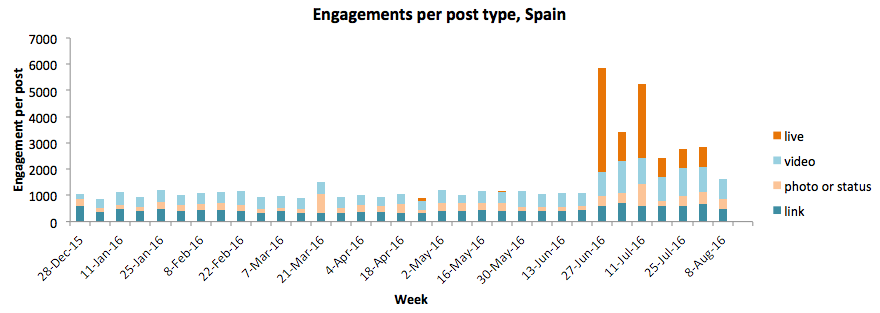
A closer look to these video posts shows what the most engaged video posts were. The top ones were made by El País, eldiario.es and ideal.es. One main contributor was a single live video starring the television programme MasterChef Spain‘s Virginia by El País.
The engagements on the week starting on 11th July stem from videos from the terrorist attack in Nice, France, on 14th July. These news events also explain why the total engagement for news went up for Spain.
Pretty viral videos from general news publishers. How did the viral news publishers do in Spain?
Spanish Viral Activity
While Facebook algorithm change might have harmed news publishers in Nordic countries, we discovered that the viral sites were not affected.
Actually, we can see an increasing trend of total engagement per viral news post in Spain.
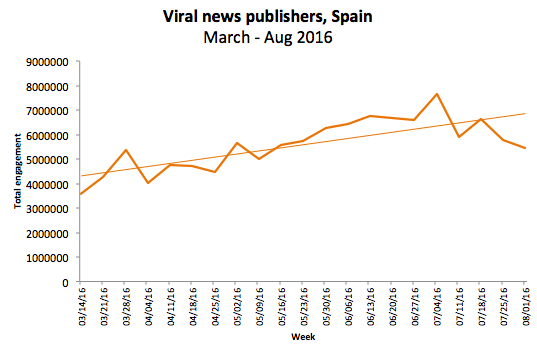
When we look at Spain’s top ten viral publishers like Genial, Perfecto and Newsner Español along with the top Nordic viral publishers, all are remarkably resilient, even increasing. The graph below shows the development trends on logarithmic scale in order to compare the trends of Nordic viral publishers and Spain (please note that the amount of viral publishers included in the data from different countries are different, and the line representing Spain is flattened).
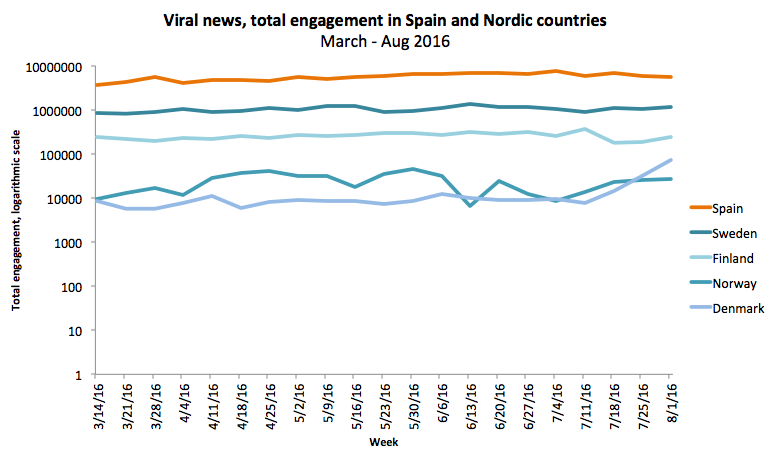
Spanish viral media, with their massive volume of engagement, tends to be different from the Nordics. It has its specialities such as the men’s entertainment sites that are in-between erotic entertainment and viral news, such Primera Línea – not at all what you’d find in the Nordics.
Despite Facebook’s recently published announcement about cutting down clickbait topics (remember viral doesn’t automatically mean clickbait). This is not visible in our data on viral news from the early August 2016.
What does this tell us?
Spain’s case shows us that Facebook algorithm changes may actually have advocated more emotionally engaging, entertainment-related posts that remind of viral news.Both general news and viral news increased their engagement rate, and it is safe to say that Spanish news media is more viral than the Nordic news media. The Spanish news publishers were so viral that they dodged the Facebook algorithm!
Spain’s case is distinctive and different from the US and Nordic countries. Yet it is also a more general example of how the line between “viral content” and general news gets thinner. In other countries, sites like BBC Trending, or Kioski of the Finnish Broadcasting Company curate viral content and make use of the viral strategies. Yet they remain public broadcasters who do not have the same commercial goals as other viral sites.
We will explore virality and new publication genres in more detail in a later post, so stay tuned!
by Varpu Rantala
